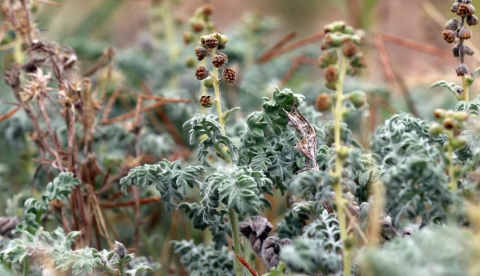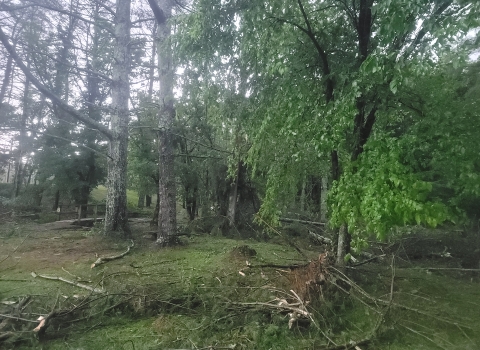| Plant Type: Perennial Herb |
| Height: 1.6 ft tall & 3 ft wide |
| Flower Color: Green, Yellow |
Listing Status
The Service listed San Diego ambrosia as endangered on July 2, 2002. The species was listed following an analysis of historical and remaining occurrences within the known species range. The loss of this species is attributed to destruction, fragmentation, and degradation of habitat.
Description
San Diego ambrosia is a clonal, perennial herb in the Asteraceae (sunflower) family. Observations indicate that it is sensitive to seasonal conditions and variations, causing the amount of above ground mass to fluctuate from year to year. San Diego ambrosia spreads vegetatively by means of slender, branched, underground root-like rhizomes from which new above ground stems (aerial stems or ramets) sprout each year. San Diego ambrosia flowers from May through October and is thought to be wind pollinated. This plant species is monoecious (possessing separate male and female flowers on the same plant).
Range
San Diego ambrosia is endemic to southern California from northwestern Riverside County, south through western San Diego County, to northwestern Estado de Baja California, Mexico. It is generally found at or below elevations of 1,600 feet (487 meters) in Riverside County and at 600 feet (183 meters) in San Diego County.
Habitat
The species generally occurs in open habitats in coarse substrates near drainages and in upland areas on clay slopes. San Diego ambrosia also occurs in a variety of associations dominated by sparse grasslands or marginal wetlands, such as river terraces, pools, and alkali playas.
Refuge Occurrence
San Diego ambrosia occurs in several locations within the Sweetwater River area of the Otay Sweetwater Unit, including a relatively large occurrence in the northeastern portion of the Sweetwater River area along an existing trail off Par Four Drive. The other occurrences, which are much smaller, are located along the north side of Highway 94 to the west of Bright Valley Farms and to the south of Highway 94, just south of the old steel bridge. In 2008 and 2010, five San Diego ambrosia population groups were established on the Otay-Sweetwater Unit in an area to the east of the Sweetwater River floodway and the south of Highway 94. The closest population group is located about 900 feet (275 meters) to the south of Highway 94, and the remaining groups extend south in a relatively linear fashion, with the last group located approximately 2,100 feet (640 meters) to the south of Highway 94. The five populations were established using plants cultivated in a nursery from rhizomes collected from the natural occurrences on the Refuge.




